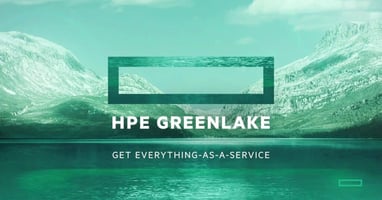HPE announced Sept. 28 its latest advances toward cloud offerings. The updates can be broken down...
HPE GreenLake’s IT Consumption Model
HPE GreenLake’s IT consumption model offers the best of both worlds in the cloud vs. on-prem debate. Talk on the topic of public cloud vs. on-premises IT and the pros and cons of each has been intensifying lately. The public cloud offers rapid, on-demand provisioning of IT resources with a pay-as-you-go funding model. On-premise IT resources can provide better data sovereignty and application performance, but require the purchase, implementation and ongoing operation of IT servers, storage and networking.

As a result, many businesses have turned to the hybrid cloud to cash in on the benefits of deploying applications in both on-premise and public cloud IT resources. However, the consensus has been the hybrid cloud is not the easiest to manage. It’s generally understood that the majority of IT resources are devoted to day-to-day operations, leaving little room for new innovation. What can be done to eliminate the operational burden on IT?
Look no further than HPE GreenLake’s IT consumption model: the as-a-service model for all your apps and data!
What is GreenLake?
HPE GreenLake’s IT consumption model marks a paradigm shift in the way IT is operated. It focuses on outcome-based consumption, while considerably simplifying IT and freeing up resources devoted to running the business. GreenLake really does deliver the best of both public cloud and on-premises IT—so you do not have to compromise on your needs.
GreenLake is HPE’s market-leading IT-as-a-service offering that brings the cloud experience to apps and data anywhere you are. Conveniently, GreenLake is a fully managed, pay-per-use model! Variable payments are based on actual usage of each individual service, using a technology specific unit of measurement, such as gigabytes of storage or number of VMs.
Why is There a Desire for Variable Payment Models?
The desire to use variable payment models has been growing. Did you know that 60% of enterprises will use flexible, lower-cost IT consumption models by 2023? This is according to an IDC report commissioned in 2019. Futurum is seeing a trend where clients are increasingly looking to move away from capital expenditure (CapEx) models, where IT equipment is bought and then depreciated over a three to five-year period, to a model where clients use operating expenditure (OpEx) to pay for infrastructure.
What is driving this trend is the need to have IT infrastructure spending better align with the IT consumption? With the CapEx model, clients were forced to predict and capacity plan to right-size their infrastructure investments for a period of three to five years. This can be costly if things do not go as planned.
The CapEx model is slow to enable dynamic businesses to respond to new and changing business needs. The CapEx model can result in scenarios where infrastructure is underutilized as business projections or priorities have changed.
Market Forces Change How Technology is Deployed
There are multiple market forces that are playing a significant role in changing the way companies are deploying technology to enable innovation and agility while leveraging the power of data to deliver next-generation customer experiences and satisfaction.
For traditional IT vendors this means more services, and not just services of the past, but the services of the future. These services require greater flexibility to match new spending models, on-demand accessibility, lower technological thresholds, and greater levels of usability. Fundamentally, it is believed there are four key market forces for traditional IT vendors that are serving as the blueprint to building and delivering next generation architectures.
- Digital Transformation: New innovative disruptors are challenging the incumbents around the globe. Usually, these new entrants are not encumbered by technical debt and are therefore able to build new streamlined IT infrastructures from scratch and leverage new technologies instantly. This puts immense pressure on incumbents who are unable to operate with a blank page and must transform what they have within legacy systems and processes.
- Modernized Experiences: The modern customer has become conditioned to leverage mobile and web as their primary interface to business. Without an appealing, user-friendly interface, clients will vote with their wallets and revenues will decline as a result. Business users demand easy and fast methods to commission and consume IT services from their internal teams. If these teams cannot deliver line of business applications quickly, executives look to shadow IT providers typically in the form of off-the-shelf SaaS and platforms from easy-to-access public cloud providers.
- Exponential Data Growth: As marketing transitions from demographics where client segments are targeted, to a demographic of one where everything is known about a client, data volumes have exponentially increased. Today’s enterprises need not only to protect their data, but many times must prove to regulators a strong governance over data retention and deletion. The increase of data volumes and increased governance over data has put detrimental stress on the IT function. The desire for common data lakes, data gravity, data sovereignty, and low latency demands can prevent company’s ability to lift and shift their data to the cloud. This forces the company to adopt a hybrid approach.
- Rapid Application Development: As digital transformation projects have been implemented to react to dynamic market forces this has led to pressure on project delivery timescales. The requirement for IT to do more and to do it quicker has become the new status quo. This has led to delivery of software applications being transformed over the last few years, with a shift away from monolithic applications to more composable ones. These innovative, agile methodologies enable project managers to bring functionality and features to users and clients often daily rather than in big drops every six to twelve months which was the norm in the past.
Factors Enabling the Change to Consumption Models
The next generation of IT application provisioning is consumption based. Futurum Research is seeing a critical change in how IT is delivered and consumed by the line of business. With mega trends such as IoT, 5G, Big Data, AI, and Cloud all impacting business simultaneously, the level of disruption is reaching a concerning level. These mega trends are impacting how IT is being delivered as a result.
The blurring of the lines between the IT function and line of business and how they operate in harmony is pivotal to success as companies look to navigate the market forces. Organizations often turn to technology to make these connections for customers. The need for on-demand consumption models becomes critical in nature; those same organizations need to realize their transformation paths. The following section discusses factors including the evolutionary nature of this type of transformation and the resources to enable this type of change.
- Consumption Driven: These models enable enterprise IT to shift their resources to meet changing business demands. Customers pay for what they use and plan capacity ahead of use to avoid over-provisioning and save on TCO (total cost of ownership).
- Resource Metering: GreenLake enables centralized resource metering and costing for resources consumed for both public cloud and on-premise applications. The metering provides projections that enable on-premise IT resources to be quickly scaled when consumption nears the capacity of the currently installed servers and storage.
- Cloud Brokerage: Customers have the ability to use cloud brokerage tooling to identify which workloads are best to move to public clouds or keep in private clouds to achieve the most beneficial mix of the hybrid cloud.
- Cloud Native Orchestration: Innovative cloud management software delivers data-driven guidance that provides customers the ability to remain in control of IT operations, policies and procedures. Also, customers will achieve increased performance and management of costs for each workload as a result. GreenLake orchestration tools bring the easy provisioning and management advantages of the public cloud to the on-premise data center.
Overall, HPE GreenLake’s IT consumption model truly delivers the best of both public cloud and on-premises IT — so you don’t have to compromise! The consumption model they deploy is designed with the customer experience at the front and center.
The ability to pay for what you use, gain clear insights into capacity requirements, quickly expand or cut back without jeopardizing the infrastructure, and flexibly roll-out workloads across a wide-spectrum of public cloud or on-premise IT resources are part of what make this model so attractive. The demand for a better experience will propel new consumption models and the expectation of delivering everything as-a-service.
ACP CreativIT has experts who would be happy to help your organization learn more about how GreenLake can benefit your business. Contact us to talk to one of our experts today.



